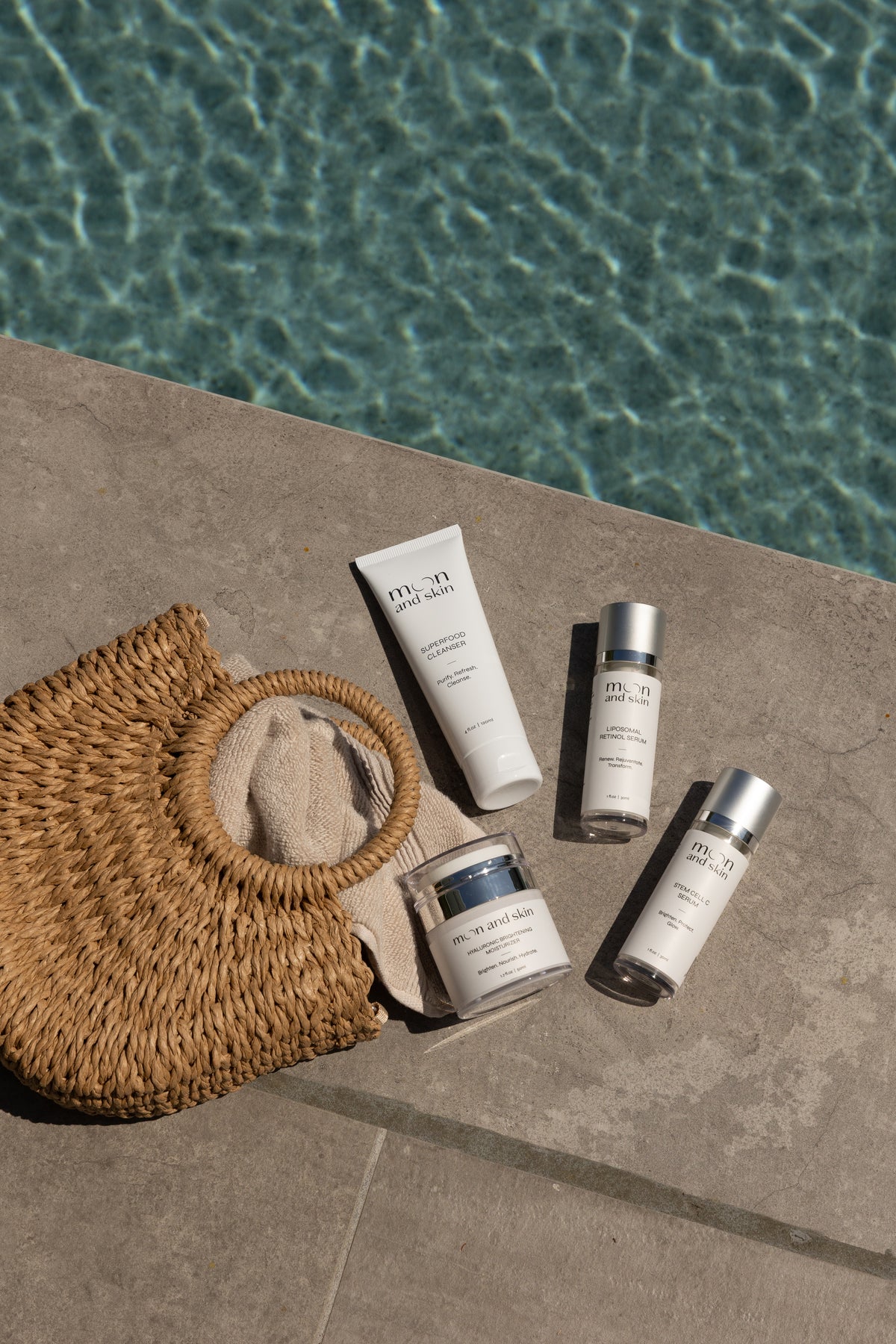Table of Contents
Introduction
Have you ever found yourself standing in the skincare aisle, overwhelmed by the myriad of products? The truth is, you're not alone. A staggering percentage of people struggle with understanding what their skin truly needs. A healthy skincare routine is essential for maintaining not just our skin's appearance, but its overall health. Yet, the essentials often get lost in the noise of marketing jargon and ever-evolving trends.
At Moon and Skin, we believe that navigating the world of skincare should be enlightening rather than daunting. Our mission is to provide clean, thoughtful formulations that support your skin through every phase of life. In this post, we will explore the fundamental components of a full skincare routine, helping you understand what you truly need to cultivate healthy, radiant skin.
Together, we’ll break down the essential steps and the beneficial ingredients that can transform your skincare experience, all while highlighting how our products can fit seamlessly into your routine.
Let’s embark on this journey to uncover the basics of a full skincare regimen and how to customize it for your unique needs.
Understanding Your Skin Type
Before we dive into the actual products, it's crucial to understand your skin type. Knowing whether you have dry, oily, combination, or sensitive skin will dramatically affect the products you choose.
1. Dry Skin
Dry skin lacks moisture and may feel tight or flaky. Individuals with dry skin should seek hydrating ingredients like hyaluronic acid, glycerin, and natural oils. Our Hyaluronic Brightening Moisturizer is a fantastic option, as it provides deep hydration while brightening your complexion.
2. Oily Skin
Oily skin is characterized by excess sebum production, leading to a shiny appearance and enlarged pores. Those with oily skin should look for lightweight, non-comedogenic products. Our Superfood Cleanser is formulated to gently cleanse without stripping the skin of its natural oils.
3. Combination Skin
Combination skin displays characteristics of both dry and oily skin. The T-zone (forehead, nose, and chin) may be oily, while the cheeks can be dry. A balanced approach is essential. Using our Liposomal Retinol Serum can help maintain balance and firmness across the face.
4. Sensitive Skin
Sensitive skin can react negatively to various products and environmental factors. Look for gentle, calming ingredients. Our Stem Cell C Serum is designed to brighten and protect without causing irritation, making it suitable for sensitive skin types.
Key Takeaway
Identifying your skin type is the first step in building a personalized skincare routine. By aligning your products with your unique skin needs, you will create a more effective regimen.
The Essential Steps of a Full Skincare Routine
Now that we have a grasp on our skin type, let’s explore the essential steps of a full skincare routine. We’ll discuss the purpose of each step, the types of products to use, and how they contribute to your skin's health.
Step 1: Cleanser
Cleansing is the foundation of any skincare routine. It removes dirt, oil, and impurities that accumulate throughout the day.
- Choose a cleanser suitable for your skin type. For dry skin, opt for a creamy cleanser that doesn’t strip moisture. Oily skin types may benefit from a gel-based, foaming cleanser.
- Use our Superfood Cleanser to nourish while cleaning.
Key Takeaway
Cleansing is vital for preparing your skin to absorb the following products effectively. A good cleanser sets the stage for a successful skincare routine.
Step 2: Toner
Toners often get overlooked, but they play a significant role in balancing your skin's pH and removing any leftover impurities after cleansing.
- Look for alcohol-free formulations to avoid over-drying your skin.
- Toners can also add hydration and prepare your skin for better absorption of serums and moisturizers.
Key Takeaway
Incorporating a toner can enhance your cleansing routine and provide additional hydration, making it a worthy addition to your regimen.
Step 3: Serum
Serums are concentrated treatments designed to target specific skin concerns like fine lines, dark spots, or dullness.
- Choose a serum that aligns with your skin goals. For brightening and protection, our Stem Cell C Serum is an excellent choice. It harnesses the power of plant-cell technology to deliver potent antioxidants directly to your skin.
- If you're looking for anti-aging benefits, our Liposomal Retinol Serum can help improve texture and firmness with minimal irritation.
Key Takeaway
Serums are the powerhouses of your skincare routine, delivering concentrated active ingredients that can make a noticeable difference in your skin’s appearance.
Step 4: Moisturizer
Moisturizers are essential for hydrating the skin and sealing in moisture. They help to strengthen your skin’s natural barrier.
- Everyone, regardless of skin type, should use a moisturizer. For oily skin, opt for a lightweight, oil-free gel. For dry skin, a rich cream may be more suitable.
- Our Hyaluronic Brightening Moisturizer is an excellent choice for its hydrating properties without heaviness.
Key Takeaway
Moisturizers help maintain skin hydration and prevent water loss. They are crucial for all skin types and should be part of your daily routine.
Step 5: Sunscreen
Sunscreen is non-negotiable for daytime skincare. Protecting your skin from UV damage is crucial for preventing premature aging and skin cancer.
- Use a broad-spectrum sunscreen with at least SPF 30, even on cloudy days.
- Consider a moisturizer with SPF for added convenience, but always ensure you apply sufficient product.
Key Takeaway
Daily sunscreen application is the most effective way to protect your skin from harmful UV rays and maintain its health.
Summary
A basic skincare routine consists of cleansing, toning, treating with serums, moisturizing, and protecting with sunscreen. Each step serves a purpose and contributes to the overall health and appearance of your skin.
Additional Steps to Consider
While the previous steps form the core of a skincare routine, you may wish to add additional steps based on your needs:
1. Exfoliation
Exfoliating helps remove dead skin cells and promotes cell turnover. It can enhance the effectiveness of your other products. However, it should not be done daily—1-2 times a week is sufficient.
- Chemical exfoliants (like AHAs and BHAs) are generally preferred over physical scrubs, which can be abrasive.
2. Face Masks
Face masks can provide targeted treatment for specific concerns, such as hydration or detoxification. They can be used as needed.
3. Eye Cream
If you have concerns about dark circles, puffiness, or fine lines, consider adding an eye cream to your routine. The skin around the eyes is delicate and deserves special attention.
Summary
Additional steps like exfoliation, masks, and eye creams can enhance your skincare routine and target specific concerns. Customize your routine based on your skin's needs.
Building Your Full Routine
To build a full skincare routine, consider the following:
- Morning Routine: Cleanser, toner, serum (like vitamin C), moisturizer with SPF.
- Evening Routine: Cleanser, toner, serum (like retinol), moisturizer.
Key Takeaway
A consistent routine is key to achieving healthy skin. Tailor your morning and evening rituals to suit your skin's needs and goals.
Conclusion
Navigating the world of skincare doesn't have to be complicated. By understanding your skin type and following a structured routine, you can achieve a radiant complexion that reflects your inner beauty.
At Moon and Skin, we offer products designed to support your skin at every phase of life. Our Bundle & Save collection allows you to create a complete skincare regimen tailored to your needs at a better value.
We encourage you to explore our best-selling products and find what works best for your unique skincare journey. With thoughtful, clean formulations, we’re here to help you celebrate your skin, just like the phases of the moon.
FAQ
1. How often should I change my skincare routine? Adjust your routine based on your skin's changing needs, especially with seasonal changes or significant life events.
2. Can I use multiple serums in my routine? Yes, but be cautious with active ingredients. It’s best to use one serum in the morning and another at night to avoid irritation.
3. What should I do if I experience irritation from a product? Discontinue use immediately and consult a dermatologist if the irritation persists.
4. Is it necessary to use a toner? While toners are not strictly necessary, they can be beneficial for balancing pH and adding hydration.
5. How can I tell if a product is suitable for sensitive skin? Look for products labeled as hypoallergenic, fragrance-free, and formulated without common irritants.
By understanding and implementing these steps, you're well on your way to achieving the healthy, glowing skin you deserve. Let's embark on this journey together!







